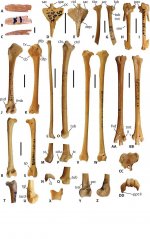Fred Ruhe
Well-known member

Vanesa L. De Pietri, Trevor H. Worthy, R. Paul Scofield, Theresa L. Cole, Jamie R. Wood, Kieren J. Mitchell, Alice Cibois, Justin J. F. J. Jansen, Alan J. Cooper, Shaohong Feng, Wanjun Chen, Alan J. D. Tennyson & Graham M. Wragg, 2020
A new extinct species of Polynesian sandpiper (Charadriiformes: Scolopacidae: Prosobonia) from Henderson Island, Pitcairn Group, and the phylogenetic relationships of Prosobonia
Zoological Journal of the Linnean Society. Online edition. doi:10.1093/zoolinnean/zlaa115
Abstract: https://academic.oup.com/zoolinnean...nnean/zlaa115/5959945?redirectedFrom=fulltext
We describe a new species of Polynesian sandpiper from Henderson Island, Prosobonia sauli sp. nov., based on multiple Holocene fossil bones collected during the Sir Peter Scott Commemorative Expedition to the Pitcairn Islands (1991–92). Prosobonia sauli is the only species of Prosobonia to be described from bone accumulations and extends the record of known extinct Polynesian sandpipers to four. It is readily differentiated from the extant Tuamotu Sandpiper P. parvirostris in several features of the legs and bill, implying ecological adaptations to different environments. The geographically nearest Prosobonia populations to Henderson Island were found on Mangareva, where it is now extinct. A previous record of a species of Prosobonia from Tubuai, Austral Islands, is here shown to belong to the Sanderling Calidris alba. Our analyses of newly sequenced genetic data, which include the mitochondrial genomes of P. parvirostris and the extinct Tahiti Sandpiper P. leucoptera, confidently resolve the position of Prosobonia as sister-taxon to turnstones and calidrine sandpipers. We present a hypothesis for the timing of divergence between species of Prosobonia and other scolopacid lineages. Our results further provide a framework to interpret the evolution of sedentary lineages within the normally highly migratory Scolopacidae.
Keywords: molecular clocks, molecular phylogeny, island fauna, Pacific Islands, palaeobiogeography, Caenozoic, fossil record, Quaternary, palaeoecology, extinction
Enjoy,
Fred
A new extinct species of Polynesian sandpiper (Charadriiformes: Scolopacidae: Prosobonia) from Henderson Island, Pitcairn Group, and the phylogenetic relationships of Prosobonia
Zoological Journal of the Linnean Society. Online edition. doi:10.1093/zoolinnean/zlaa115
Abstract: https://academic.oup.com/zoolinnean...nnean/zlaa115/5959945?redirectedFrom=fulltext
We describe a new species of Polynesian sandpiper from Henderson Island, Prosobonia sauli sp. nov., based on multiple Holocene fossil bones collected during the Sir Peter Scott Commemorative Expedition to the Pitcairn Islands (1991–92). Prosobonia sauli is the only species of Prosobonia to be described from bone accumulations and extends the record of known extinct Polynesian sandpipers to four. It is readily differentiated from the extant Tuamotu Sandpiper P. parvirostris in several features of the legs and bill, implying ecological adaptations to different environments. The geographically nearest Prosobonia populations to Henderson Island were found on Mangareva, where it is now extinct. A previous record of a species of Prosobonia from Tubuai, Austral Islands, is here shown to belong to the Sanderling Calidris alba. Our analyses of newly sequenced genetic data, which include the mitochondrial genomes of P. parvirostris and the extinct Tahiti Sandpiper P. leucoptera, confidently resolve the position of Prosobonia as sister-taxon to turnstones and calidrine sandpipers. We present a hypothesis for the timing of divergence between species of Prosobonia and other scolopacid lineages. Our results further provide a framework to interpret the evolution of sedentary lineages within the normally highly migratory Scolopacidae.
Keywords: molecular clocks, molecular phylogeny, island fauna, Pacific Islands, palaeobiogeography, Caenozoic, fossil record, Quaternary, palaeoecology, extinction
Enjoy,
Fred
Last edited:






